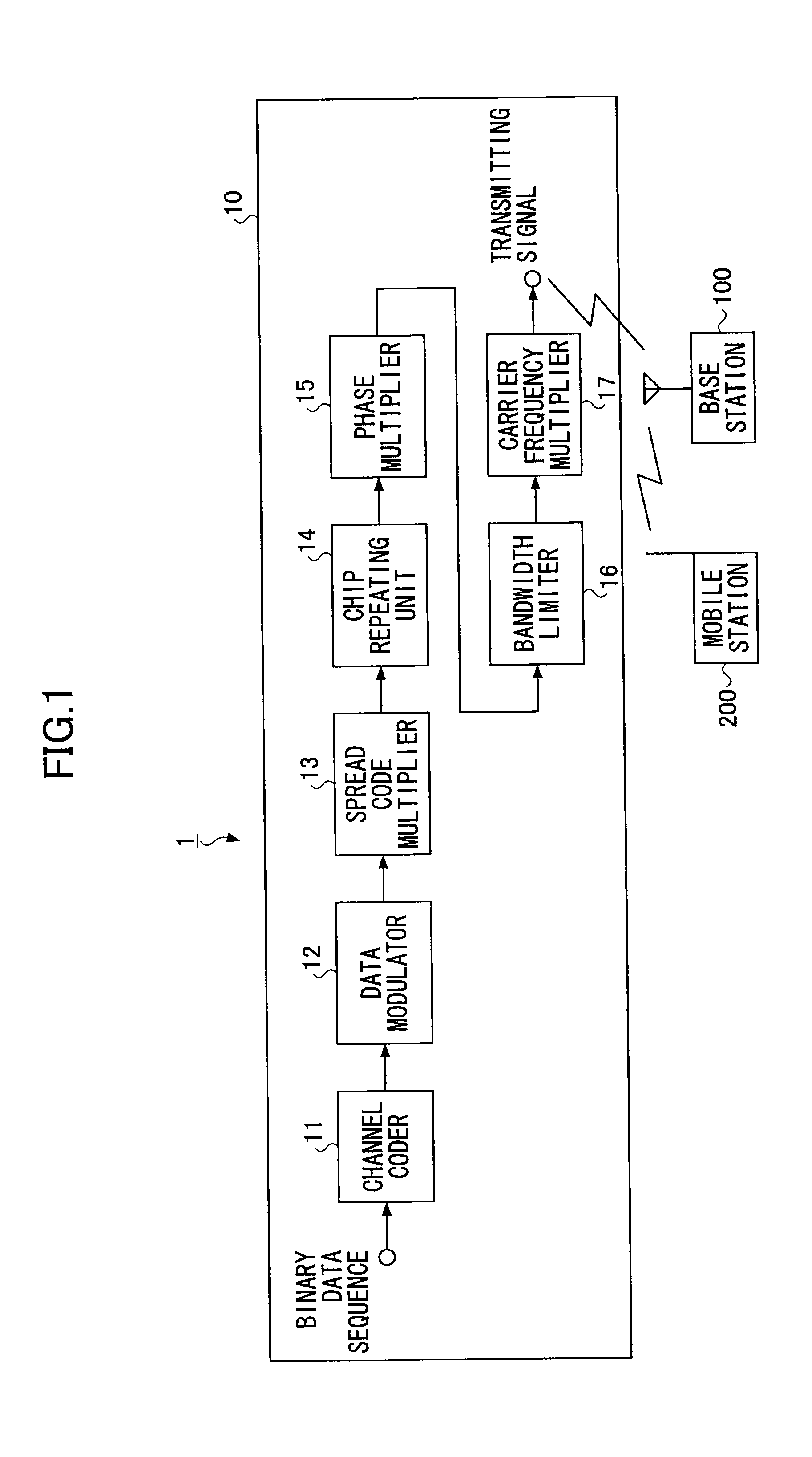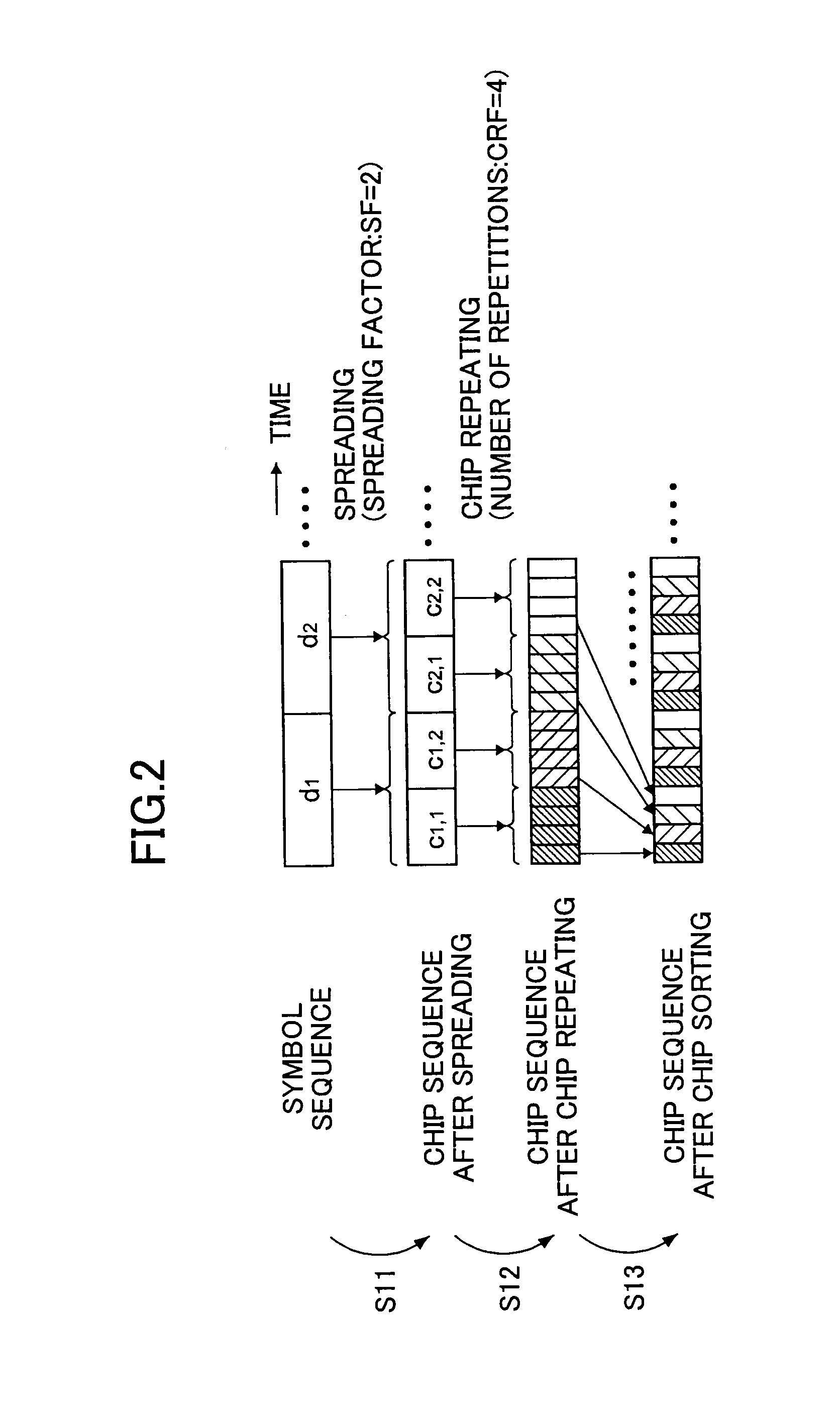Mobile station capable of and a method for generating chip patterns for transmission
a mobile station and chip pattern technology, applied in the field of wireless transmission technology, can solve the problems of difficult to increase the spectral usage efficiency in the multi-cell environment and the isolated cell environment, and achieve the effects of increasing the spectral usage efficiency, increasing the link capacity, and increasing the link capacity
- Summary
- Abstract
- Description
- Claims
- Application Information
AI Technical Summary
Benefits of technology
Problems solved by technology
Method used
Image
Examples
first embodiment
A First Embodiment
[0094]First, a configuration of a wireless transmission system according to a first embodiment is described. As illustrated in FIG. 1, a wireless transmission system 1 includes a mobile station 10 and a base station 100. The mobile station 10 transmits a wireless signal spread by multiplying spreading code. The mobile station 10 includes a channel encoder 11, a data modulator 12, a spreading-code multiplier 13, a chip repetition unit 14, a phase multiplier 15, a bandwidth limiter 16, and a carrier-frequency multiplier 17.
[0095]The channel encoder 11 performs channel coding by applying error-correction code such as Turbo code and convolution code. The data modulator 12 modulates the channel-coded data. The spreading-code multiplier 13 multiplies spreading code to the modulated data so as to generate spreading-chip sequence. The chip-repetition unit 14 performs chip repetition for a predetermined number of repetitions to the spreading-chip sequence so as to generate ...
second embodiment
A Second Embodiment
[0100]While an exemplary aspect of applying on a fixed basis SF=2 as the spreading factor and CRF=4 as the number of repetitions is illustrated in the first embodiment, in a wireless transmission system according to the present embodiment, a mobile station comprises a function of variably controlling spreading factor of spreading code and the number of chip repetitions.
[0101]A wireless transmission system 2 according to the second embodiment has the same basic configuration as the wireless transmission system 1 as detailed in the first embodiment. Therefore, numerals of the same column (with the same tail-ends) are assigned to the mobile station and its elements so as to omit the description while detailing below the differences from the first embodiment, referring to FIG. 4 and FIG. 5.
[0102]FIG. 4 is a schematic diagram of an overall configuration of the wireless transmission system 2 and a configuration of a mobile station 20 according to the present embodiment....
third embodiment
A Third Embodiment
[0108]While an exemplary aspect which variably controls the spreading factor and the number of chip repetitions based on the spreading factor and the number of chip repetitions reported from the base station is shown in the second embodiment, the mobile station comprises a function of variably controlling the spreading factor and the number of chip repetitions based on the cell environment reported from the base station in the wireless transmission system according to the present embodiment.
[0109]A wireless transmission system 3 according to the third embodiment has the same basic configuration as the wireless transmission system 2 detailed in the second embodiment. Therefore, numerals of the same column (with the same tail-ends) are assigned to the mobile station and its elements so as to omit the description as well as detailing below the differences from the second embodiment, referring to FIG. 6 through FIG. 8.
[0110]FIG. 6 is a diagram of an overall configurati...
PUM
 Login to View More
Login to View More Abstract
Description
Claims
Application Information
 Login to View More
Login to View More - R&D
- Intellectual Property
- Life Sciences
- Materials
- Tech Scout
- Unparalleled Data Quality
- Higher Quality Content
- 60% Fewer Hallucinations
Browse by: Latest US Patents, China's latest patents, Technical Efficacy Thesaurus, Application Domain, Technology Topic, Popular Technical Reports.
© 2025 PatSnap. All rights reserved.Legal|Privacy policy|Modern Slavery Act Transparency Statement|Sitemap|About US| Contact US: help@patsnap.com



